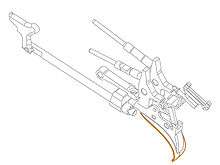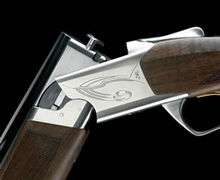Cynergy Shotgun
The Browning Cynergy Over and Under Shotgun is a firearm introduced by Browning in 2004. It is considered by most to be the first Over and under shotgun to depart from the basic design criteria that had been associated with over and unders since the early 20th century.
The Browning Company also makes the Browning Citori line of over and under shotguns. The Cynergy and the Citori are manufactured at the Miroku Firearms Manufacturing plant in Kochi, Japan. The Cynergy is substantially different in its design from the original Browning Superposed designed by John Moses Browning, and its successor the Citori (which is largely derivative in design from the Superposed.)
Mechanism differences
Mechanical Trigger: Based on the trigger system found in a rifle, Cynergy shotguns feature a reverse striker. The reverse striker is a mechanical trigger system that uses an actuator to reverse the direction of the impact force from the spring to the firing pin. Essentially, when the action opens up, the strikers must cock by a `pull' rather than a `push.'" This design offers the benefit of reduced locktime.

Monolock Hinge: The purpose of this design is to create a lower profile receiver. The system integrates the hinge and locking system. The MonoLock Hinge pivots on significantly more surface area than guns with conventional low profile receivers. Rectangular locking pins provide additional strength while a wear-in relief feature allows for wear without hindering lock-up.

History of the design
The beginning of the Cynergy technically begins with the original B-25 Superposed, designed by John M. Browning in 1928 and finished for production using a single trigger with barrel selector by his son Val Browning by 1939. Production continued on the Superposed until production costs hurt the Superposed in the marketplace during the late 1960s. The basic design was taken to Browning's partner, the Miroku Company in Japan, and in 1971 the Citori over and under went into production. From that point the Citori took the place of the Superposed as the primary Browning over and under shotgun.
In the early 1990s the idea of a complementary gun to the Citori was being discussed by all the Browning design teams in Belgium, Utah and in Japan. [1]
In 1994, at a management retreat in Alaska, the worldwide team determined to begin exploring ideas. Independent design projects began and in 1996 the teams came together in Belgium to discuss three basic ideas. First was a design with a reverse-type hinge system presented by Joseph Rousseau, a master Browning gun designer from Belgium, now living in Morgan, Utah. The second was a low profile receiver concept being worked on by the experienced Browning designer Joseph Mardaga, who was a member of the Browning R&D team in Herstal, Belgium. Third was a design featuring a double firing pin concept specifically created to provide exceptionally fast lock times.
About this time Dwight Potter joined Browning as a gun designer in Morgan, Utah. Potter had worked for many years prior designing robotic manipulators . . . telerobotics systems used on everything from submarine manipulators to animatronics at some of the world's most famous theme parks. [2]
By 1997 the Cynergy project became official under the code name of "Sheik" and Potter was put on the project full-time as lead designer, working closely with Master Browning gun designer, Joseph Rousseau, who was now the firm's VP of Research and Development.
The Cynergy design was to be based on the reverse hinge concept put forward by Rousseau several years earlier With the decision to proceed Potter designed all the internal mechanisms. This took over two years of design work resulting in the first prototype coming out of Browning's model shop in Morgan, Utah in 1999. Both Potter and Rousseau are listed on the patent documents for this design. [3]
Working closely with Rousseau, Potter designed the Cynergy's reverse striker system which assured very fast lock times. He created a striker type ejection system and integrated a toggle-type safety/selector. Potter's design assured good function with the mechanical triggers via a design utilizing an inertia block that prevents doubling while preserving fast lock times.
By 2001 Browning partner, Miroku, had produced the first design verification prototypes. In 2004, the new Cynergy was introduced to the public at the annual Shooting, Hunting and Outdoor Trade Show (SHOT Show) - a full decade after the original ideas were discussed in Alaska.
Many have called the Browning Cynergy "revolutionary". Ever since the invention of the Browning Superposed over and under, most manufacturers have relied on the basic principles incorporated by John M. Browning to create their own over and unders, each one adapting and evolving from previous designs. The Cynergy represents the first major rethink of the over and under concept in nearly a Century. As such, it incorporates all of the most desirable features every shooter wants. The Cynergy achieves them through forward thinking ideas and manufacturing methods, in the same manner John M. Browning did when he broke new ground with his designs starting over 125 years ago. From a historical point of view, the Cynergy shows that the innovative thinking started by John M. Browning is still alive and well at Browning today.
Sources
- Patent Storm
- © Browning, used with permission.
- Gun Week
- Browning
- Shooting UK
- Browning, John M., American Gunmaker. Browning, John & Curt Gentry. 1964.
- "American Gunmaker: The John M. Browning Story." Documentary. Written and Produced by Lee B. Groberg
- Business Week
- Striking shotgun designs for the 21st Century, Guns Magazine, June, 2004 by Holt Bodinson
- Browning eBlast Newsletter, June, 2008. © Browning 2008, used with permission.
- Over-and-under shotgun apparatus and method. Joseph F.N. Rousseau, Mountain Green, Morgan County; Dwight M. Potter, Liberty, Weber County. Assigned to Browning Arms Co., Morgan. Filed Jan. 5, 2005, a continuation of Patent No. 6,907,687, filed Dec. 2, 2002. Patent No. 7,207,130.